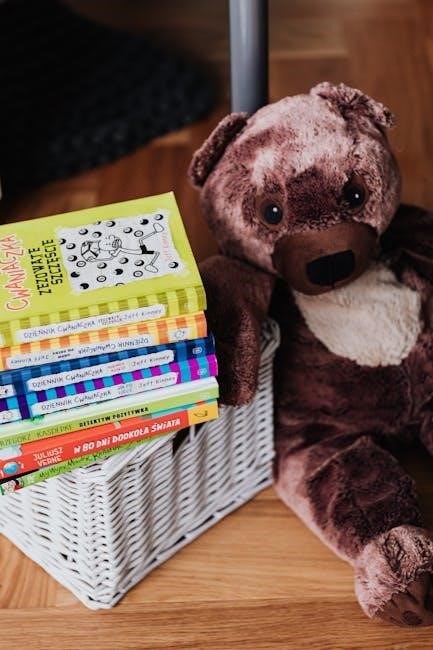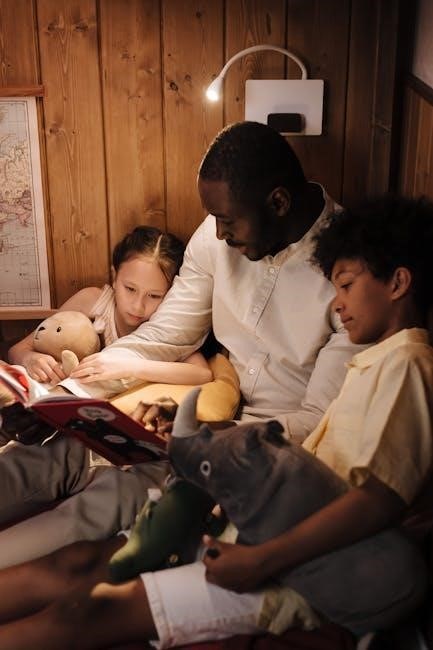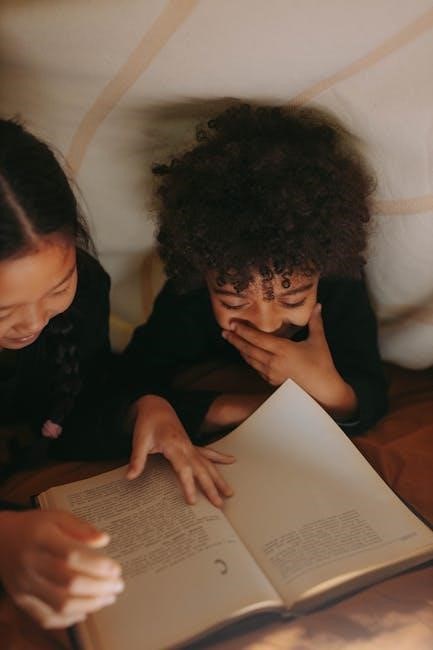The story of Goldilocks and the Three Bears is a beloved fairy tale about a curious girl who ventures into a bear family’s home. While the bears are away‚ Goldilocks samples their porridge‚ sits in their chairs‚ and sleeps in Baby Bear’s bed. This charming tale teaches valuable lessons about respect‚ boundaries‚ and responsibility‚ making it a timeless classic in children’s literature.
1.1 Overview of Goldilocks and the Three Bears
Goldilocks and the Three Bears is a classic fairy tale about a curious girl named Goldilocks who stumbles upon the home of a bear family while they are out for a walk. The story revolves around her mischievous exploration of their house‚ where she samples their porridge‚ sits in their chairs‚ and eventually falls asleep in Baby Bear’s bed. Her actions lead to a surprising confrontation when the bears return home. The tale is simple yet engaging‚ with vivid imagery and moral lessons about respect for others’ property and the consequences of curiosity; Its timeless appeal lies in its ability to captivate children with its relatable characters and straightforward narrative‚ making it a staple in children’s literature and a popular choice for PDF storybooks.
1.2 Significance of the Story in Children’s Literature
Goldilocks and the Three Bears holds a significant place in children’s literature due to its enduring popularity and educational value. It is a timeless tale that has been passed down through generations‚ captivating young readers with its simple yet engaging narrative. The story’s moral lessons about respect for others’ property and the consequences of curiosity are conveyed through relatable characters and situations‚ making it an effective tool for teaching children important life values. Additionally‚ its availability in PDF formats has made it easily accessible‚ ensuring its continued relevance in modern times. The story’s ability to adapt to various adaptations and interpretations further highlights its lasting impact on children’s literature.

Main Characters in the Story
- Goldilocks: A curious and adventurous girl with golden hair.
- Father Bear: The protective and large patriarch of the bear family.
- Mother Bear: The caring and nurturing matriarch of the household.
- Baby Bear: The innocent and smallest member of the family.
2.1 Goldilocks: The Curious Girl
Goldilocks is the central character of the story‚ known for her curiosity and adventurous spirit. She is a young girl with golden hair who stumbles upon the bears’ house while wandering in the forest. Her curiosity drives her to explore the house‚ leading her to taste the porridge‚ sit in the chairs‚ and sleep in Baby Bear’s bed. Goldilocks’ actions are often seen as both mischievous and naive‚ showcasing her youthful innocence. Her character serves as a lesson about boundaries and the consequences of one’s actions. Despite her mistakes‚ Goldilocks’ charm and relatability make her a memorable figure in children’s literature.
2.2 Father Bear: The Protective Parent
Father Bear is the patriarch of the bear family‚ known for his strength and protective nature. He is a large‚ authoritative figure who ensures the safety and well-being of his family. As a provider‚ he works to maintain a comfortable home for Mother Bear and Baby Bear. His protective instincts are evident when he returns home to find their porridge tampered with and their chairs broken. Father Bear’s deep voice and firm demeanor emphasize his role as a guardian‚ adding depth to the story. His reaction to the intrusion highlights the importance of respecting others’ property and the consequences of one’s actions‚ making him a key figure in conveying the moral lessons of the tale.
2.3 Mother Bear: The Caring Homemaker
Mother Bear is portrayed as a nurturing and caring figure‚ dedicated to maintaining a warm and welcoming home for her family. She is often depicted as the voice of reason‚ balancing Father Bear’s sternness with her gentle nature. Her role as a homemaker is central to the story‚ as she prepares meals and keeps the house tidy. Mother Bear’s porridge‚ which Goldilocks finds too sweet‚ reflects her thoughtful preparation for her family’s needs. Her calm demeanor contrasts with the chaos caused by Goldilocks‚ showcasing her patience and dedication. Mother Bear’s character highlights the importance of care and domestic harmony‚ making her a vital part of the bear family’s dynamic and the story’s moral fabric.
2.4 Baby Bear: The Innocent Victim
Baby Bear‚ the youngest member of the bear family‚ is depicted as an innocent and vulnerable character. His small size and gentle nature make him the most affected by Goldilocks’ actions. When Goldilocks breaks his chair‚ eats his porridge‚ and sleeps in his bed‚ Baby Bear is left feeling distressed and violated. His innocence and helplessness evoke sympathy from readers‚ emphasizing the impact of Goldilocks’ careless behavior. Baby Bear’s character serves as a reminder of the importance of protecting the vulnerable and respecting others’ belongings‚ making him a pivotal figure in the story’s moral lessons and emotional appeal.

The Plot Summary
The story begins with the three bears leaving their house while their porridge cools. Goldilocks discovers their home‚ samples the porridge‚ breaks a chair‚ and sleeps in Baby Bear’s bed. Upon the bears’ return‚ they find Goldilocks‚ leading to a frightened escape and a lesson learned.
3.1 The Bears’ Morning Walk
The three bears—Father Bear‚ Mother Bear‚ and Baby Bear—decided to go for a morning walk while their porridge cooled. Father Bear‚ with his deep voice‚ suggested the outing to allow their breakfast to cool down properly. Mother Bear‚ being the caring homemaker‚ ensured everything was tidy before they left. Baby Bear‚ full of energy‚ was excited to explore the forest. They locked their cozy little house and set off‚ unaware of the unexpected visitor who would soon arrive. The bears’ walk in the forest was peaceful‚ with no hint of the mischief that awaited them back home.
3.2 Goldilocks’ Discovery of the Bears’ House
Goldilocks‚ a curious girl with golden hair‚ wandered through the forest and stumbled upon the bears’ cozy cottage. She knocked on the door‚ but when no one answered‚ her curiosity got the better of her. Finding the door unlocked‚ she boldly entered the house. Inside‚ she discovered the neatly arranged dining table with three bowls of porridge. The enticing aroma and her hunger drew her closer. With no one in sight‚ Goldilocks felt a sense of freedom to explore‚ unaware of the chaos she was about to unleash. Her boldness led her to investigate further‚ setting the stage for a series of mischievous acts.
3.3 Tasting the Porridge: Too Hot‚ Too Cold‚ Just Right
Goldilocks’ curiosity led her to the dining table‚ where three bowls of porridge sat. She tasted the first bowl‚ belonging to Father Bear‚ and found it too hot. Next‚ she tried Mother Bear’s porridge‚ but it was too cold. Finally‚ she sampled Baby Bear’s porridge and declared it “just right.” Satisfied‚ she ate the entire bowl. This act of tasting and judging the porridge showcased Goldilocks’ impulsive nature and lack of hesitation in exploring someone else’s belongings. Her actions set the stage for further mischief‚ as she continued to snoop around the bears’ home‚ unaware of the consequences her curiosity might bring.
3.4 Breaking the Chairs: Goldilocks’ Mischief
After tasting the porridge‚ Goldilocks’ curiosity turned to the living room‚ where she spotted three chairs. She decided to test them‚ starting with Father Bear’s large chair. It was too hard‚ so she moved on to Mother Bear’s chair‚ which she found too soft. Finally‚ she sat in Baby Bear’s tiny chair‚ exclaiming‚ “This chair is just right!” However‚ as she rocked back and forth‚ the chair broke under her weight. The breaking of the chair highlighted Goldilocks’ reckless behavior and lack of care for others’ belongings. This act of mischief added to the chaos she had already caused‚ further setting the stage for the bears’ eventual discovery of her presence.
3;5 Falling Asleep in Baby Bear’s Bed
Tired from her mischief‚ Goldilocks ventured upstairs and found three beds. She first lay in Father Bear’s bed‚ declaring it “too hard‚” then tried Mother Bear’s‚ which she deemed “too soft.” Finally‚ she rested in Baby Bear’s bed‚ finding it “just right.” Overcome with exhaustion‚ she fell fast asleep. The bears returned home to find their porridge tasted‚ chairs broken‚ and a stranger in Baby Bear’s bed. Startled by their presence‚ Goldilocks awoke‚ screamed in fright‚ and fled out the window into the forest. This chaotic ending taught Goldilocks a lesson about respecting others’ property and boundaries‚ while the bears learned to secure their home from curious intruders.
3.6 The Bears’ Return and the Confrontation
After their walk‚ the three bears returned home to find their house in disarray. Father Bear noticed his porridge had been tasted‚ Mother Bear saw her chair was broken‚ and Baby Bear discovered his bed had been slept in. Startled by the sight of Goldilocks asleep in Baby Bear’s bed‚ the bears growled in unison‚ “Who has been sleeping in my bed?” Goldilocks awoke‚ saw the bears staring at her‚ and screamed in fright. Terrified‚ she quickly jumped out of the window and ran into the forest‚ never to return. The bears‚ though shaken‚ were relieved to have their home back and vowed to be more cautious in the future.

Moral Lessons from the Story
Goldilocks and the Three Bears teaches respect for others’ property‚ consequences of curiosity‚ and the importance of family unity‚ providing timeless lessons for children.
4.1 Respect for Others’ Property
Goldilocks and the Three Bears emphasizes the importance of respecting others’ property. Goldilocks’ actions—entering the bears’ house‚ eating their porridge‚ breaking their chairs‚ and sleeping in Baby Bear’s bed—highlight the consequences of disrespecting others’ belongings. Her curiosity leads to damage and disruption‚ teaching children that taking or using things without permission is wrong. This lesson encourages kids to appreciate boundaries and understand that respecting others’ property is essential for maintaining trust and harmony in relationships. The story serves as a simple yet effective way to instill this moral value‚ showing how Goldilocks’ disregard for the bears’ belongings leads to fear and chaos‚ ultimately teaching her a valuable life lesson.
4.2 Consequences of Curiosity and Mischief
Goldilocks’ curiosity and mischievous actions lead to significant consequences in the story. Her unauthorized entry into the bears’ home results in the destruction of their property‚ such as breaking Baby Bear’s chair and eating their porridge; These actions disrupt the bears’ peaceful lives and cause distress‚ especially for Baby Bear‚ who feels violated by the intrusion. When the bears return and discover Goldilocks asleep in Baby Bear’s bed‚ she is forced to flee in fear‚ highlighting the repercussions of her reckless behavior. This teaches children that curiosity‚ when paired with disobedience‚ can lead to unpleasant outcomes and harm to others. The story underscores the importance of self-control and considering the impact of one’s actions on others.
4.3 The Importance of Family Unity
The story of Goldilocks and the Three Bears highlights the strength of family unity in overcoming challenges. When the bears return home to find their porridge tasted‚ chairs broken‚ and beds slept in‚ they work together to address the situation. Their collective effort to restore order demonstrates the importance of teamwork and mutual support within a family. The bears’ unity helps them navigate the disruption caused by Goldilocks’ actions‚ showcasing how families can rely on one another during difficult times.
The bears’ ability to communicate and resolve the issue together reinforces the value of strong family bonds. Their unity not only helps them recover from the intrusion but also strengthens their relationship‚ emphasizing the importance of togetherness in maintaining harmony and resolving conflicts.

Historical Background of the Story
Goldilocks and the Three Bears is a traditional English fairy tale first published by Robert Southey in 1837. Originally featuring an old woman‚ it evolved to include Goldilocks‚ becoming a beloved story worldwide.
5.1 Origins of the Fairy Tale
Goldilocks and the Three Bears is a traditional English fairy tale with roots tracing back to oral storytelling traditions. The story’s earliest known version was written by Robert Southey in 1837‚ featuring an old woman as the intruder. Over time‚ the character evolved into Goldilocks‚ a curious girl with golden hair‚ making the tale more appealing to children. The story’s origins are deeply embedded in European folklore‚ reflecting themes of curiosity‚ consequences‚ and family unity. Its evolution over the years has led to various adaptations‚ ensuring its place as a timeless classic in children’s literature.

5.2 The Role of Robert Southey in Popularizing the Story
Robert Southey played a pivotal role in popularizing Goldilocks and the Three Bears through his 1837 literary work. His version‚ titled “The Story of the Three Bears‚” introduced the tale to a wider audience‚ adapting it into a written narrative. Southey’s storytelling skills and creative adjustments‚ such as initially featuring an old woman instead of Goldilocks‚ helped shape the story’s structure. His work laid the foundation for future adaptations‚ making the tale a staple in children’s literature. Southey’s contribution ensured the story’s enduring appeal‚ allowing it to evolve and remain a beloved classic across generations.
5.3 Evolution of the Story Over Time
Goldilocks and the Three Bears has undergone significant changes since its origins. Initially‚ the story featured an old woman rather than Goldilocks‚ as introduced by Robert Southey in 1837. Over time‚ the main character evolved into a curious young girl with golden hair‚ enhancing the story’s appeal to children. The tale’s moral lessons and structure have remained consistent‚ but adaptations have added unique twists‚ such as the bears’ distinct personalities and Goldilocks’ defining traits. Modern retellings have further diversified the narrative‚ incorporating new themes and visuals while preserving its timeless charm. These adaptations ensure the story’s relevance across generations‚ maintaining its place as a beloved classic in children’s literature.

PDF Versions of the Story
6.1 Where to Download the PDF
6.2 Features of the PDF Version
The PDF version of Goldilocks and the Three Bears is designed to enhance storytelling with vibrant illustrations and clear text. Many versions include colorful‚ engaging visuals that bring the characters and their adventures to life. The PDF format ensures that the story is easily readable on various devices‚ making it accessible for both home and classroom use. Interactive features in some editions allow children to click and explore elements of the story. Additionally‚ the PDF retains the original tale’s moral lessons‚ ensuring it remains both entertaining and educational. These features make the PDF a versatile tool for parents and educators seeking to captivate young readers while imparting important life lessons.
6.3 Tips for Reading the PDF with Children
Reading the PDF version of Goldilocks and the Three Bears with children can be a delightful experience. Encourage interaction by asking questions about the story and its moral lessons. Use the vibrant illustrations to spark discussions about the characters and their actions. For younger children‚ read aloud slowly and pause to explain key events. Older children can take turns reading portions of the text‚ fostering a love for storytelling. Emphasize the importance of respecting others’ property and the consequences of curiosity‚ as highlighted in the story. This engaging approach ensures the tale remains both entertaining and educational for young minds.

Creative Expressions of the Story
The story of Goldilocks and the Three Bears has inspired various creative adaptations‚ including illustrated books‚ animated films‚ and theatrical performances‚ bringing the tale to life visually and dynamically.
7.1 Illustrations in the PDF
The PDF versions of Goldilocks and the Three Bears are enriched with vibrant and engaging illustrations that bring the story to life. These visuals depict the bear family’s cozy home‚ Goldilocks’ curious exploration‚ and the iconic moments of tasting porridge‚ breaking chairs‚ and sleeping in Baby Bear’s bed. The illustrations vary in style‚ ranging from traditional watercolor to modern digital art‚ catering to different reader preferences. They play a crucial role in helping children visualize the narrative‚ making the story more immersive and enjoyable. Additionally‚ the visuals often include expressive characters‚ enhancing the emotional depth of the tale for young readers. The illustrations are a key feature that makes the PDF versions a popular choice for parents and educators alike.
7;2 Adaptations in Theater and Film
The story of Goldilocks and the Three Bears has been adapted into various theater productions and films‚ offering fresh interpretations of the classic tale. Theater adaptations often feature lively performances‚ with actors bringing the characters to life through dialogue and physical comedy. In film‚ the story has been reimagined using animation and live-action formats‚ with some versions adding modern twists to the narrative. For instance‚ a circus-themed adaptation creatively incorporates acrobatics and slapstick humor‚ while others focus on heartfelt storytelling. These adaptations maintain the core themes of curiosity and consequence while appealing to new audiences. The story’s versatility makes it a popular choice for both stage and screen‚ ensuring its enduring appeal across generations.
7.3 Modern Retellings of the Story
Modern retellings of Goldilocks and the Three Bears have creatively reimagined the classic tale for contemporary audiences. These adaptations often feature fresh twists‚ such as Goldilocks being a kind visitor rather than a mischievous intruder‚ or the bears welcoming her into their home. Some versions incorporate humor‚ while others explore themes of empathy and understanding. Digital media and interactive books have also brought the story to life‚ allowing readers to engage with the characters in new ways. These modern interpretations maintain the story’s charm while offering fresh perspectives‚ ensuring its relevance for new generations of readers and storytellers alike.

Educational Value of the Story
The story teaches children about boundaries‚ respect for others’ property‚ and responsibility‚ while fostering a love for reading and sparking creativity through its timeless lessons.
8.1 Teaching Children About Boundaries
The story of Goldilocks and the Three Bears is an excellent tool for teaching children about boundaries. By entering the bears’ house without permission‚ Goldilocks crosses personal and property boundaries‚ leading to consequences. This narrative helps kids understand the importance of respecting others’ space and belongings. The tale vividly demonstrates how crossing boundaries can lead to discomfort and conflict‚ encouraging children to think critically about their actions. It also highlights the value of privacy and the need to ask for permission before taking something that doesn’t belong to them. Through this simple yet impactful story‚ children learn essential life lessons about respect and responsibility.
8.2 Encouraging a Love for Reading
The story of Goldilocks and the Three Bears is a captivating tale that encourages children to develop a love for reading. Its simple‚ repetitive structure and engaging storyline make it accessible to early readers. The colorful characters and moral lessons create a sense of curiosity and connection‚ fostering a deeper interest in storytelling. Reading the story aloud‚ especially with expressive dialogue and rhythm‚ can make the experience interactive and enjoyable for children. The availability of PDF versions with illustrations further enhances the reading experience‚ making it visually appealing and easier for young learners to follow. This classic fairy tale not only entertains but also enriches a child’s understanding of language and narrative‚ laying a strong foundation for lifelong reading habits.
8.3 Using the Story in School Curriculums
The story of Goldilocks and the Three Bears is widely used in educational settings to promote learning and engagement. Teachers often incorporate the tale into literacy programs to enhance reading comprehension and creative writing skills. The story’s moral lessons‚ such as respect for others’ property and consequences of actions‚ align with character education initiatives. Additionally‚ the narrative’s repetitive structure and vivid imagery make it ideal for teaching language development and sequencing skills. Schools also use PDF versions of the story for digital classrooms‚ enabling interactive activities and group discussions. This timeless tale serves as a versatile tool for fostering critical thinking‚ creativity‚ and social-emotional learning in students of all ages.
Goldilocks and the Three Bears remains a timeless tale‚ charming readers with its simple yet profound lessons. Its enduring popularity ensures its place in children’s literature and education.
9.1 The Timeless Appeal of Goldilocks and the Three Bears

The story of Goldilocks and the Three Bears has captivated audiences for generations‚ blending humor‚ morality‚ and relatable characters. Its enduring appeal lies in its simplicity and universal themes‚ making it accessible to children and adults alike. The tale’s clear moral lessons about respect‚ boundaries‚ and responsibility resonate deeply‚ while its lighthearted tone ensures it remains a delightful read. The story’s adaptability has allowed it to evolve through various retellings‚ illustrations‚ and adaptations‚ keeping it fresh and engaging. Its ability to teach valuable life lessons while entertaining has solidified its place as a timeless classic in children’s literature and education.
